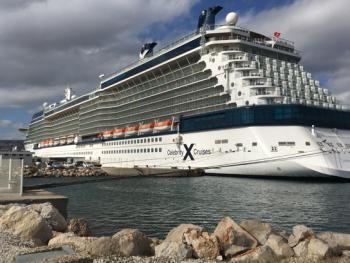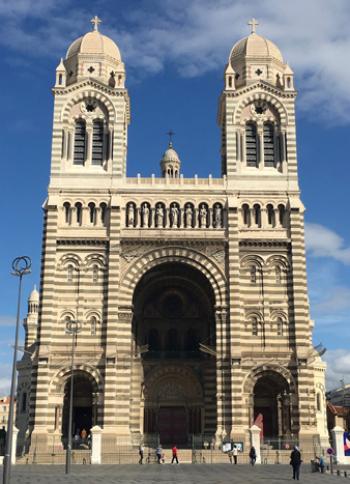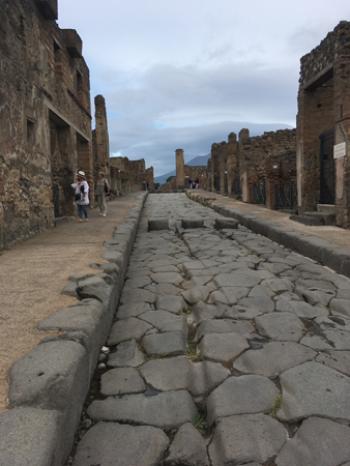Dialysis on a Mediterranean cruise
This item appears on page 17 of the May 2020 issue.
To treat my travel bug after two years of cabin fever and the humdrum routine of medical appointments, hospitalizations, surgeries and bouts with dialysis, I prescribed myself a dialysis-at-sea cruise of the Western Mediterranean aboard the Celebrity Eclipse of Celebrity Cruises (888/751-7804, www.celebritycruises.com). I did this with the assistance of Brandie Debroux of Dialysis at Sea (800/54407694, ext. 205; brandie@dialysisatsea.com).
My travel companion, Patrick Karst, and I flew from Los Angeles on Oct. 3, 2018, arriving in Barcelona the following evening. We sped through baggage claim and Customs formalities and wearily settled into a cab that could accommodate my travel scooter and walker plus our luggage. After a night in a hotel, we headed to the ship.
The Celebrity Eclipse has strict boarding requirements. Luggage had to be placed on conveyor belts for screening. No liquor was allowed. Also not permitted on board was my power strip with three AC outlets and three USB ports; they claimed it was a fire hazard [see “No Surge Protectors at Sea,” March ’18, pg. 14]. They also confiscated the coffeepot “hazard” that Patrick had purchased during one of our tours.
On Deck 3, our 200-square-foot, accessible stateroom (No. 103) included two queen beds, a refrigerator and an expansive bathroom with a body-beating hot shower. For the two of us, the tab for all this luxury (no excursions included) was $5,974. Dialysis (not covered by Medicare but by secondary insurance, if approved) cost another $4,410. Our travel insurance through TravelSafe (800/461-6920, www.travelsafe.com) cost $4,496.
We had no time to inspect the 2,850-passenger ship. Dumping our luggage in our stateroom, we ascended to Deck 14 for our meeting with 16 other dialysis patients and our support crew. During the 14-day cruise, my schedule required a total of six morning dialysis sessions, each lasting three hours.
The Dialysis Center was located near the hospital on Deck 2. Two cabins with two hospital beds each were allotted to a nephrologist and four nurses.
Each session provided me time to relax. The three hours of exchange between me and the machine was less tedious than it tends to be on land. Time went rapidly, thanks to my cheerful and efficient nurse, Carla, my fellow dialysis patient, Joan, and the books stored in my iPad.
As for meals, I always maintain a strict renal-failure diet (low salt, potassium and phosphorus and four cups or less of liquid per day) — indeed, a challenge on a cruise.
There were a variety of specialty restaurants on the ship, and though Patrick and I dined twice at our assigned table in the Moonlight Sonata dining room, our preference was the scenic international buffet, with its large variety of tempting, delicious food, where dining was casual and we could observe passing ships.
The ship stopped at many ports, some of which I’ll mention. One of our favorites was Alicante, Spain. On our own, Patrick and I strolled along the Paseo de La Explanada, a maritime promenade running parallel to the port and lined with restaurants, cafés and souvenir stalls. The elegant boulevard of red, black and cream tiles was bordered by tall, graceful palm trees.
Alicante is noted for its nougat. It was Sunday, so most shops were closed, but we found a market open and I purchased several boxes for €2 each.
In Málaga, Spain, we took “Tapas Tasting in Málaga” ($70 each plus gratuity), the first of three shore excursions that we had booked with Celebrity prior to boarding the ship.
At the tour’s first stop, the Alcazaba, I was instructed to remain on the coach because of the fortress’ many challenging steps. While the group toured, I was startled when the driver suddenly drove the coach away. Was I being kidnapped? Was he going for fuel? My Spanish is rudimentary, so I sat and wondered. It finally dawned on me that he was treating me to a private tour of the city! After we returned to pick up the group that had toured the fortress, the drive was repeated.
The coach dropped us all off at the Plaza de la Merced, and Cherie, a dialysis nurse, joined Patrick and me in exploring the Old Town on our own. We followed suggestions we had been given by our shore tour’s outstanding and knowledgeable guide, Baimundo Maitrate.
Baimundo’s lunch recommendation of La Dehesa (Calle Bolsa 3, Málaga; phone +34 952 21 21 32) was the highlight of the day. We were delighted with his entrée suggestions of delicious boquerónes (fried anchovies) and fried eggplant with honey and cane sugar. For the three of us, the total cost for all this was €13.40 (near $15) plus €8.50 for a carafe of outstanding house wine.
The ship’s next stop was Marseille, France, where, on our own, Patrick and I meandered around the Cathédrale Sainte-Marie-Majeure. The present cathedral, with 3,000 seats, is immense, one of the largest in France. It was built around an earlier, 12th-century cathedral, part of which remains alongside.
To our dismay, when we docked at Nice, I was confined to the ship. Sadly, neither my scooter nor my walker were allowed on the tender to the port.
In Livorno, Italy, we boarded a coach for a winery tour offered by Celebrity ($70 each). After taking a guided tour of the cellars to see how the wines were produced, we nibbled on salami and bruschetta while tasting white and red wines.
Civitavecchia, the port for Rome, was our next stop. However, due to a dialysis session, my visiting Rome, 1½ hours away, was not doable, so Patrick and I simply explored the port town.
On a ship’s excursion from Naples, we boarded a coach to Pompeii ($39 each). Pompeii’s main street, Via dell’Abbondanza, was scooter-accessible, but there were several places in the paved streets where blocks were placed in the road for pedestrian crossings. Patrick carried my scooter over several of them.
Pompeii was a spectacular sight — the Forum; the Ionic columns of the arcade; the Suggestum, from which orators spoke; the remains of the Basilica, and the Temple of Jupiter. Mt. Vesuvius towered over the remains.
Upon the ship’s return to Barcelona, we disembarked on Oct. 17.
On this cruise, our favorite and most unforgettable excursions were those that were on our own. We should have opted for independence throughout the cruise.
I hope this description of my Mediterranean adventure encourages those with disabilities like mine to continue to travel. As a former teacher, I maintain that travel is the best educator. With an open mind and flexibility, one discovers, learns about and appreciates people and their culture, food, history and daily challenges.
Indeed, travel is happiness, and memories of adventures in 150 countries keeps me happy.
DOROTHY CHANG VAN HORN
Manhattan Beach, CA



